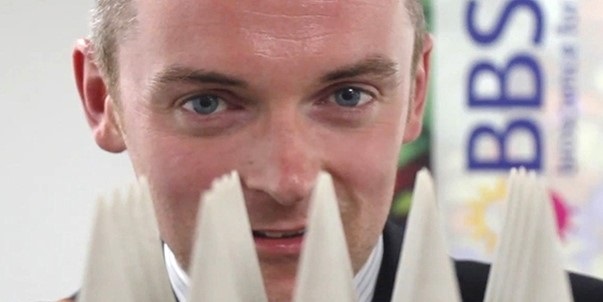Hydrogel-based Microneedles
The future of safe drug delivery

Dr Ryan Donnelly explains how hydrogel-based microneedles might be the future of safe drug delivery, and how they could be used for non-invasive blood monitoring.
What we're working on are hydrogel-forming microneedle arrays (about 600µm high) formed on a solid support. What's unique about our microneedles is that they are made out of these hydrogel-forming polymers which are hard in dry state, so they will penetrate the outermost layer of the skin the stratum corneum. However, upon skin penetration they rapidly take up skin interstitial fluid to form many minute hydrogel plugs in the skin, and what this does is create a continuous unblockable conduit between the external environment and the dermal microcirculation.
There are two principal uses of this technology. The first is delivering large molecules across skin that you would be unable to deliver by that route, such as peptides, proteins; the likes of insulin or vaccines. But it can also be used for conventional small molecule drugs that have been developed for oral delivery which are too water soluble to penetrate the stratum corneum which is essentially an oily barrier.
The second main use is minimally invasive patient monitoring. Because the concentration of most drugs in skin interstitial fluid is in balance with that in blood plasma, if we can use a microneedle patch to extract interstitial fluid then we have a way of blood-free patient monitoring. This has particular applications in the monitoring of premature babies. These patients are typically on many medicines to keep them alive, due to their vulnerability. However, since each neonate is different and their organs are at an indeterminate stage of development, then it is vitally important that drug concentrations are monitored to optimise therapy and minimise side effects.
The difficulty also lies in the fact that these children are small, very fragile, with a limited volume of blood. It can be difficult to find a vein and a conventional needle can cause bruising and scarring. Also, you're basing the dose on body weight or surface area and titrating down from an adult dose, but children are not simply small adults and their organs will not be fully developed when they are premature, so new minimally methods of monitoring in this patient population is desirable.
This opens up great possibilities for enhancing patient care by providing a safe and effective way of delivering and monitoring a wide range of compounds, and greatly enhances the value of the transdermal drug delivery and patient monitoring markets, so there's considerable value for industry with this innovation.
The benefit of our technology, with respect to other types of microneedles, is the fact that the microneedles are removed intact from the skin – they don't deposit polymer behind in the skin. But they are also self-disabling – even after one minute in skin they become too soft to ever be reinserted – meaning they don't need to be disposed of as contaminated sharps waste and alleviating any fears of accidental contamination or transmission of infection.
BBSRC funded the first grant that we got on the microneedle technology back in 2007. So BBSRC began funding the work in its infancy. The first thing we looked at was the delivery of protein and peptide drugs - things like insulin and vaccine antigens as well. That proved the concept and to fully characterise the system and work out its capabilities and make adjustments on a molecule-by-molecule basis. And all of the success that we've achieved to date, industrial interactions, and further funding from EPSRC and the Wellcome Trust for example, has all been as a result of that initial BBSRC grant.
Since that grant, we've had two major grants from BBSRC: first to look at patient safety; the second just announced within the last month was a large grant from the new Super Follow-on Fund to scale up microneedle manufacture to an industrial scale of production.
The other grants include an EPSRC three-year programme which is ongoing on minimally invasive patient monitoring, and Action Medical Research have funded a programme of work to follow on the neonatal monitoring because they're a children's charity, as well as a Wellcome Trust five-year study on microneedle behaviour in skin and skin recovery after microneedle removal. Then we have five awards from major companies looking at small molecule delivery, gene based vaccination and cosmeceutical delivery.
All these industrial interactions are to demonstrate the capability of the technology with molecules right up to and including animal studies. What this all hinges on, of course, is the ability to scale up manufacture of microneedles, which is why we were so delighted with BBSRC's continued support of the technology through the Super Follow-on Fund. And we're currently working with a major transdermal patch manufacturer to take forward the work on the BBSRC.
We have one step application – the microneedles don't need to be stuck in and taken out - it's applied and that's that. And in contrast to silicon or metal microneedles, there is little likelihood of patient-to-patient contamination, as the microneedles are self-disabling; they take up interstitial fluid and become soft so you could never stick them in another person.
Over the next two years we'll be working very hard on the Super Follow-on Fund and collaborating with partners in transdermal patch manufacture to scale up. We will also continue to work with our other industrial partners. Another important matter working forward is to address regulatory concerns, so well will be interacting with regulatory groups in the UK and internationally to find out any perceived issues, but we're confident we can easily address them.